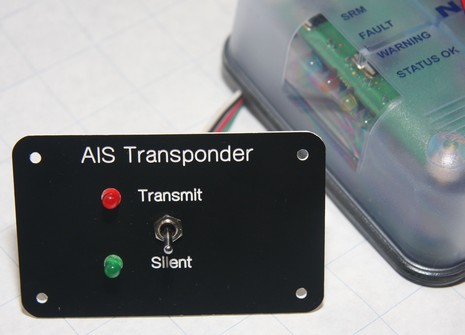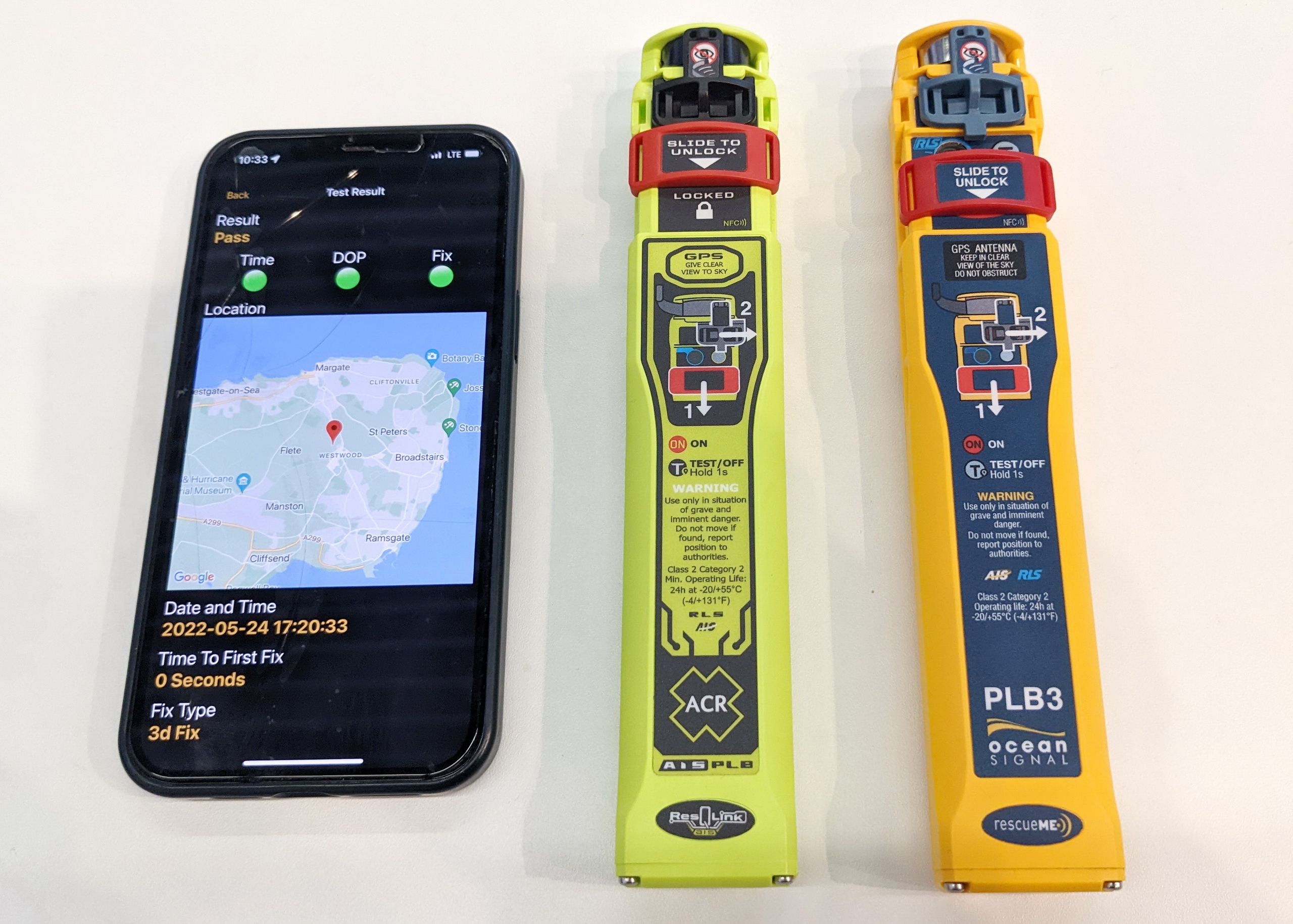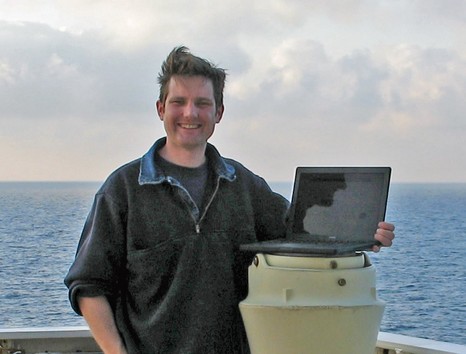Nauticast B mod, a “silent” mode switch

Most Class B AIS units have an SRM/Silent Mode switch on their casing, but the ACR Nauticast B instead provides a wire to a user-supplied switch. The plus is that you can more easily mount the transponder remotely, the minus is that you do have to install a switch, or only use the included software to control the functions. Incidently, that same software (similar to this) lets you choose the switch function: either to go in and out of silent (receive only) mode or to send a SRM (Safety Related Message, so far little used). At any rate, longtime Panbo reader Dan Gingras—a known LED fan—built the handsome Nauticast B switch above, and has kindly shared his design…
As you can see below, Dan’s LED circuit is pretty simple (he recommends TheLEDLight.com for helpful diagrams). “The power is from the panel switch that also powers the Nauticast B so that when I switch the little unit on, one of the LED’s will light depending on whether it’s in transmit or not. I used HOT GLUE to pot the back of the switch (a bit of a messy job, but it works) to hold the delicate 470 ohm resistor and insure that it doesn’t get shorted out.” Dan also sent a photo of the back and it is, um, less handsome than the the custom engraved front, but apparently the whole deal tests just fine. He’s also thinking of installing a Vesper AIS Watchmate (which recently got upgraded to include target graphics) as an alternate front end to the transponder. I look forward to reports from Dan about how well his Class B performs on the water. Actually I’d like to see as many Class B real world performance reports as possible, as it seems especially important now that we know the USCG is trying to decide which coastal commercial vessels will be permitted to use it instead of Class A transponders.













Transmit is red and silent is green ? Not the other way around ?
Dan,
It could be either, but I wanted to show when I was consuming more power as red. Actually now that I look at the diagram, it’s shown opposite of the way it actually works, so wire it like the diagram and it will be green for transmit and red for silent!
Dan
The NAIS-300, an NMEA 2000 class B AIS unit, also has a ‘Silent Mode’ transmit disable switch. However, you would think this would/could be done from a configuration screen but not so.
SimRad should change this since it would have every advantage that software configuration has, you wouldn’t have to wire a switch and it could be controlled anywhere from on the NMEA bus. How often do you want to disable transmit? Does this really warrant another switch/wire or shouldn’t it just be a configuration screen.
If everyone’s running around in “silent mode” what’s the point?
Interesting though, last year while heading down the coast we where stopped & boarded by USCG small boat crew near Province Town for a routine check. Our flares where expired & so noted (we carry a Furuno FA150 Class A). On our first outing earlier this year just outside of our home port (Clinton, CT) a CG small boat zoomed in & first question was had we added flares with a current date! Which we had, but still the whole point of AIS, I feel, is to see & be seen.
John
John, I think a lot of boaters won’t give a hoot about Silent mode, but there seem to be two groups that do care. One is world cruisers who want to be stealthy around pirates. I haven’t actually heard of pirates using AIS receivers, but I wouldn’t be surprised if they were.
The other group is commercial and sport fishermen who are often damn secretive about where they are. It’s pretty amazing how much energy and money is spent on comms equipment meant to let buddies share hotspots privately, or meant to ferret out where non-buddies are. For instance, check around a big sport fishing marina some time and see how many direction finding VHF antennas you see. Those are expensive systems used specifically to home in on other fishermen who might know something you don’t.
I’d be concerned with the unit being in the wrong mode and not noticing. The LED panel is a great idea!
If the USCG mandates AIS-B for certain classes of vessels, disabling the transmitter that makes it a B – instead of a dumb receiver – on a vessel of the named class would be illegal, surely. I suppose a commercial fisherman who disabled the transmitter could be busted by the Coasties.
You’re correct, Larry, and it’s spelled out clearly in the USCG’s proposed new ruling about “effective operating conditions”:
“* continual operation of AIS and its associated devices when underway, at anchor, or moored in or near a channel, except when its use would compromise safety or security (securing an AIS for the later must be logged and reported to USCG).”
But only commercial fishing vessels over 65′ will be mandated to carry AIS if the proposed rules are enacted. And of course no recreational sport fishing boats or even head boats under 50 passengers (unless they go over 30 knots) will be mandated to carry AIS (we must keep repeating that because people are paranoid about the gov’mint).
But I hope a lot of non-mandated vessels decide to carry AIS when they realize how robust and useful the system is. If you read the NPRM referenced in the last entry, you’ll that USCG feels the same way: The more AIS the better for all.
I think there is another reason to use the silent switch… noise. My son, who is a 2nd officer on big container ships says he’s concerned about harbor clutter and ECDIS alarms. My sense is that if they CAN filter out class B information they may, so I can’t really see why I want to be transmitting my information when I’m in Boston Harbor on a clear day. I figure it’s my responsibility to keep out of the way of large commercial traffic regardless of the COLREGS.
Offshore or in reduced visibility sure, but there’s really no sense in adding to the clutter or stress of a bridge officer when there’s no need. Nor is there any reason to consume power when I’m at anchor and want to “listen” to AIS traffic around me.
My .02 about going silent
Dan
That’s an interesting thought, Capt. DanG (dang, I like that handle). I tend to think that both the “problem” of too many targets and the possibility of filtering them out are both overstated. But I really don’t know, and have been asking questions.
Yesterday I got confirmation that “the minimum keyboard display (MKD) required of all AIS Class A does not allow for such filtering” from an unimpeachable source, though I think there are some paranoid cruisers who wouldn’t believe that if an Admiral told them to their face!
I also learned that “new international navigation presentation standards applicable to radar, ECDIS, ECS, ARPA, etc. (IEC 62288, 2008) allow the filtering (for example, by target range, CPA/TCPA or AIS target class A/B, etc.) of sleeping AIS targets* (but, not active AIS targets). However, the filter process used to limit the number of displayed targets should ensure that priority is given to displaying targets that have an impact on the safety of own ship. Additionally, sleeping AIS targets must be automatically activated when they meet user defined parameters (for example, target range, activation zones, CPA/TCPA or AIS target class A/B).
* A sleeping AIS target, indicates the presence of a vessel equipped with AIS in a certain location, however, no additional information is presented until the AIS target is activated. The target is represented by a “sleeping target” symbol indicating the vessel’s orientation.”
So it sounds to me like the powers that be are working on ways to make busy AIS plotting work well, i.e. make sense for everyone’s safety, both Class A and Class B equipped vessels.
It’s also occurred to me that if an AIS-equipped boat ever accidentally ran down a Class B boat and it was determined that the accident might not have happened if said vessel had not filtered out the run down vessel, there would be liability hell to pay.
>>>If the USCG mandates AIS-B for certain classes of vessels, disabling the transmitter that makes it a B – instead of a dumb receiver – on a vessel of the named class would be illegal, surely. I suppose a commercial fisherman who disabled the transmitter could be busted by the Coasties.
Posted by: Larry Brandt at December 19, 2008 1:20 AM
Agreed Ben.
Maintain a proper lookout ” . . by all available means appropriate in the prevailing circumstances and conditions . . . . . ”
Without doubt this includes AIS and to filter out certain traffic would be in contravention of Rules 5 and 7.
Foggy, I have seen both USCG and US Navy ships on AIS target plots, but not consistently. And they do have special privileges.
Good points Ben. My son’s concerns aside, I think that if the USCG is going mandate Class B for certain classes of vessels, then ALL vessels will have to show all B targets.
I can’t wait to get it installed. Unfortunately it’s snowing right now!!
I agree, DanG! I believe that will the standard, and we’ll figure out ways to make it work. I like the “sleeping” idea above—i.e. a dimmed-out, don’t-worry-about-me target image that’s on screen but hopefully not bothersomely on screen. I also like the idea that no type of target, be it Class B or vessels under xx’ or whatever, can be deemed permanently asleep; i.e. the operator must consciously decide at what CPA a sleeping AIS target becomes ACTIVE.
I think this is all going to work out fine.
I expect the comment that “ships will filter out the noise of Class B AIS” will keep popping up. If not expressed tactfully, it makes it sound like ships don’t care about running over small boats. The “I didn’t see him” excuse may work, but the “I wasn’t looking” excuse will not. Explicit regulations or a legal precedent would help settle this question.
Personally, I don’t see this desire to filter Class B arising as a fault of AIS but rather as a fault of the display systems. I too find it annoying when something pops up to cover an important chart feature. It’s a User Interface problem, not an AIS problem. Someone could have a nice user interface for AIS display that shows targets without filtering indiscriminately, but it will probably be a long time before everybody has one.
The Table of Contents for IEC 62288-2008 is here
http://webstore.iec.ch/preview/info_iec62288%7Bed1.0%7Den.pdf
(the full document is available for a price)
Nice switch design, I recently installed an ACR Nauticast unit and have been thinking about if and how I will do the silent mode switch.
Interestingly, on my first voyage with the AIS transponder, when I was about 10 miles off the coast of St Vincent, a customs boat zoomed out from shore, circled me and zoomed back. I have never experienced that in the West Indies (nor heard of it happening to others). I suspect they saw me on AIS and came out to check me out, perhaps confused by the class B data.
The transponder did prove useful on the 4 day passage, several ships hailed me when they saw me and noted that they had to adjust their radars to see me there (I am only 36′ and fiberglass) but I readily showed up on their AIS.
My only wish is that the raymarine E80 had an option for a longer range alarm. 2 miles may be handy nearshore, but I would much prefer a 10 mile alarm for offshore work.
To a degree, Furuno already offers filtering. The MFDxx manual says:
Ignoring AIS Targets
In the default setting, all AIS targets within 12 nm from your boat are shown on the display. If the screen becomes cluttered with AIS targets, you may wish to remove some of them from the display by specifying a different display range. Slow-moving targets within the AIS proximity alarm range will cause frequent triggering
of the AIS proximity alarm. You may wish to prevent this by ignoring targets within the alarm range that are slower than a threshold value.
So targets outside a certain distance will not appear at all, and targets moving slower than the specified speed won’t trigger an alarm. Setting that speed threshold at 10kts pretty much gets rid of alarms from recreational traffic, though the target would still be on the screen. I don’t know if there is a similar capability on their commercial grade plotters and I assume this capability is not on the FA-150 display.
Hi Russ,
As far as i am aware the FAR-2xx7 Series Radars do not have filtering (its ais interface can show 1000 ais targets not sure what happens when it exceeds 1000! or what will be included in the new software to conform to the latest IMO regs.
The FA-100 / 150 do not filter ais at all.
(latest sw is require to decode class b static data)
Furuno ECDIS i would assume is the same as the FAR-2xx7 but will check when i get 5 mins.
If a thousand AIS targets are cluttering a plotter screen, what is happening to the radar screen? Do we think big ships filter out all those little law suits just to see the big law suits better?
For a recreational boater, AIS is a blessing in the see and avoid department. The more you can see, the more you can avoid. With the advent of mandated AIS B on smaller commercial vessels, and those doing more than 30 knots, we can see threats that aren’t constrained to deep channels.
A switchable AIS B is a blessing in the see and be seen department, which can be used when needed, as in channels, harbors, and sea lanes, at the captain’s prerogative.
Little law suites and big law suites hmm.
Currently i would assume (with radars cpa etc) i would assume it would filter less dangerious targets.
At the end of the day the colission regs do not excuse a small boat of not avoiding a collision due to right of way.
In the end the only saying that really exists is “Might is right”
Wow, this is a lot of debate over one little switch!
Just a note about the AIS switch panel for the ACR Nauticast B. ACR recommends that the switch be a momentary-contact switch. This is so that when used in Safety Related Message mode it won’t send repeatedly. If you use the non-momentary switch and then change the function of the switch, you may have some issues with confusing functionality.
Hi, we are sailing across the Bay of Biscay and our AIS system has switched itself to silent mode. We are unable to switch it back on, the information booklet isn’t giving us any help and it’s driving us nuts! Is there anyone out there with some idea’s of how to switch it back on?
Thanks Amanda
What brand and model of AIS transponder, Amanda? Some have a button on them that can control silent mode, some have a wire for a silent mode switch, and some can be switched via software control from an attached PC.